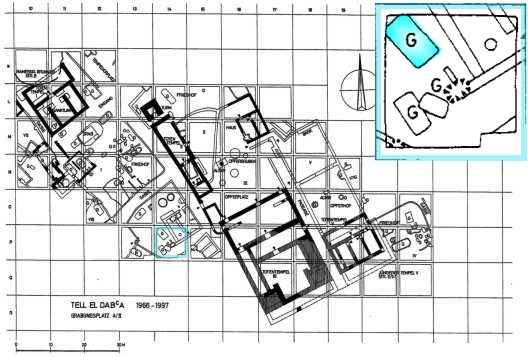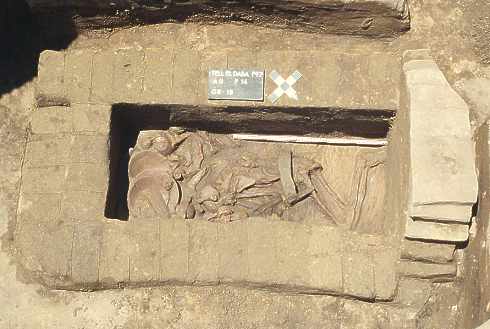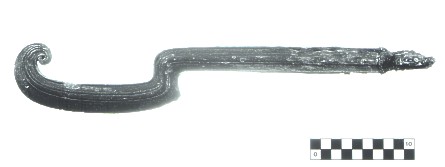RECENT FIND OF A WARRIOR TOMB WITH A SERVANT BURIAL IN AREA A/II AT TELL EL-DAB'A IN THE EASTERN NILE DELTA
Since 1966 excavations directed by Manfred Bietak have been conducted at Tell el-Dab'a, ancient Avaris, capital of the Hyksos by the Austrian Archaeological Institute Cairo and the Institute of Egyptology of the University of Vienna. During the 1997 Spring Season new investigations were initiated in A/II (fig. 1) where previous excavations had revealed a mortuary precinct with several cemeteries belonging to the 2nd Intermediate Period. It was the aim of this project to define more closely the stratigraphy of the tell area.

Fig. 1: Tell el-Dab'a, ancient Avaris, area A/II
A new cemetery situated to the west of the main temple's enclosure wall was uncovered. Several strata of burials dating from the late 13th Dynasty to the very end of the Hyksos Period could be discerned. Three main types of burials were found: vaulted mud brick tombs set into pits, simple pit burials, and infant burials in large vessels of Egyptian and foreign origin (amphorae, beer bottles, zîrs). The total number of burials in this relatively small area is 32.
A remarkable feature is that most were undisturbed and therefore produced good material for further stratigraphical and chronological analysis.
The most prominent tomb was p/14 - Nr. 18 [L 468]. This main tomb of stratum F (transitional MBIIA to MBIIB periods) was orientated NW-SE with the burial chamber (measuring 2,65 x 1,65 m) and single vault constructed of mud-bricks. The vault collapsed some time after the covering of the tomb and seemed therefore to be destroyed by grave-robbers. Luckily this conclusion was not confirmed when the tomb was opened by the excavators. A single equid skeleton was found in the entrance area together with a round bottomed cup and a jar. Next to the northeastern wall a young female servant was buried in a slightly contracted position looking towards the tomb chamber. The body was placed in this position at the time of the main burial (fig. 2). Because of the circumstances of this and other burials of the period there is a strong possibility that the girl was offered to her master as a human sacrifice.

Fig. 2: Tell el-Dab'a, warrior tomb
The warrior was put into his tomb in a supine slightly contracted position with his head towards the entrance. On his left hand was found an amethyst scarab; possibly belonging to a now lost ring. He was buried with his weapons and an assemblage of different pottery types. Bones of goats or sheep placed on a dish next to his head are remains of a meat offering. He wore a copper belt with an attached dagger with five middle ribs on his left side. In his arms he held a scimitar still in its sheath. The sword itself was made of copper and well preserved; the sheath, consisting of an organic material, probably leather, is still to be examined, the handle was made of bone. The blade is cast with a riveted socket, it's point voluted and therefore unique (fig. 3). It is the oldest specimen of this type yet found in Egypt.

Fig. 3: Tell el-Dab'a, scimitar from the warrior tomb
An overall view of the funerary equipment in ist combination of Egyptian and foreign goods and Egyptian and foreign habits confirms the typical picture of most tombs belonging to this period in Tell el-Dab'a. The tomb is accompanied by several other partly excavated tombs and seems to be at the centre of the group, possibly a hint at social implications.
Further research on this and related topics is currently being undertaken as part of the SCIEM 2000 project (http://www.nhm-wien.ac.at/sciem2000/), a special research program of the Austrian Academy of Sciences and the Austrian Science Fund in order to create a chronological framework for the history of the Second Millenium B.C. in the Eastern Mediterranean.
Further reading:
M. Bietak, Tell el-Dab'a V. Ein Friedhofsbezirk der Mittleren Bronzezeitkultur mit Totentempel und Siedlungsschichten. Teil I. UÖAI VIII (Wien 1991)
M. Bietak, Avaris. Capital of the Hyksos. Recent Excavations at Tell el-Dab'a. Sackler Lecture (London 1996)
I. Forstner-Müller, Ä&L 10 (2000) in press
© Irene Forstner-Mueller
e-mail:
Irene.Forstner-Mueller@oeaw.ac.at
This article will be quoted by I. Forstner-Mueller, Recent find of a warrior tomb with a servant burial in area A/II at Tell el-Dab'a in the Eastern Nilt Delta, Forum Archaeologiae 12/IX/99 (http://farch.tsx.org/forum0999/12tell.htm).




